Tottori
last update: May 09, 2022
Tottori (鳥取), capital of the prefecture of the same name, is a town of about 200,000 inhabitants located in the west of the country, along the coast of the Sea of Japan. Just along the coast, a few kilometers from the city center, is the attraction that made Tottori known to everyone, namely the largest sand dunes in Japan.
Things to do and things to see in Tottori
The sand dunes of Tottori
The
Tottori Sand Dunes (鳥取砂丘, Tottori Sakyu), located just outside the city center, is Tottori's most popular tourist attraction. The dunes were formed over a period of about one hundred thousand years, thanks to the sand brought into the sea by the nearby Sendaigawa River and redeposited along the coast by ocean currents. The sandy area has decreased a lot in the last century, due to a government reforestation program launched after the Second World War, but in recent decades the authorities have changed their approach, trying as much as possible to contain the shrinkage of the dunes, which in the meantime have become an important tourist attraction in the area. The landscape is constantly changing, with the constant movement of the tides and coastal winds that continually shape the shapes of the sand dunes.
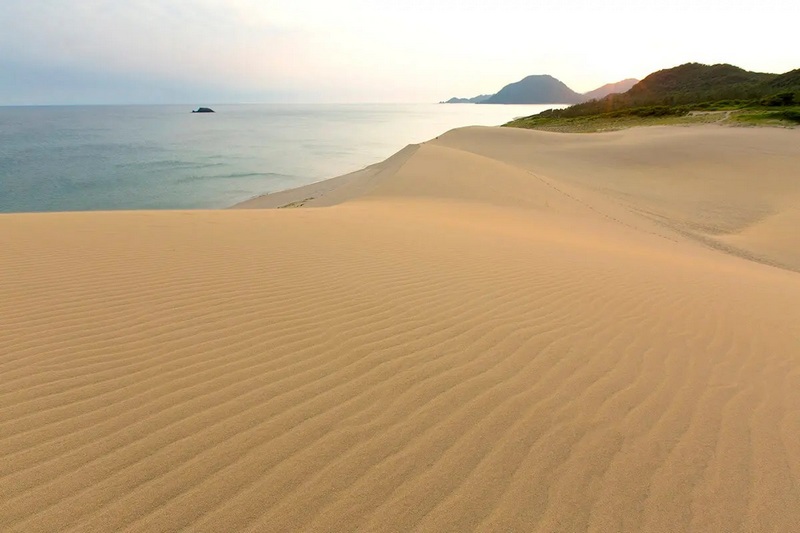
Some guides claim that they extend up to 16 kilometers along the coast of the Sea of Japan, however the actual area one usually goes to and where one can enjoy a "desert" feeling is much smaller, about 2 km long in front of the sea, from east to west, and no more than a km wide towards the city. The main thing to do here is to walk and climb the highest dunes to admire the desert landscape and the sea. For a more unique experience it is recommended to visit them very early in the morning, before most of the tourists arrive.
There are also a number of other small attractions you can do. The most popular is the
camel ride or horse drawn carriage (1500¥ per person), less popular but definitely more adventurous are the
paragliding and
sandboarding (a variant of snowboarding) activities. A few meters from the main car park in the area there is a museum (
The Sand Museum) Finally, the dune area is connected by a panoramic chairlift (300¥) to the
Sakyu Center.
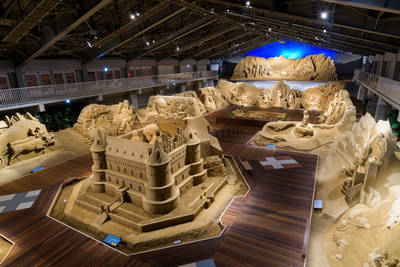
The Sand Museum
(admission 800¥, opening hours 9-18, until 20 on saturday)
This museum is located a few meters from the main car parks to visit the dune area. It is a unique museum, which exhibits large sand sculptures by artists from all over the world. The exhibits usually change annually and run from mid-April to early January of the following year, but sometimes the closing periods are longer. Each exhibition has its own theme, typically a country or region of the world, of which famous monuments or other symbols are reproduced. You can check the current exhibition and, above all, the closing months, on the official website.
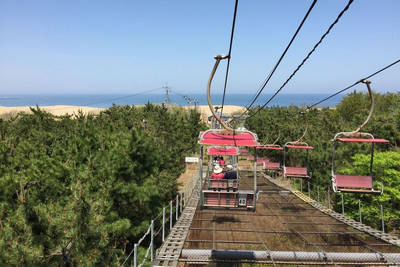
Sakyu Center
This building is located next to one of the large car parks near the dune area. Inside you will find a large souvenir shop, a restaurant, a panoramic roof terrace and the departure station of a chairlift that takes you directly to the dunes.
The city center
The city center, often ignored by tourists who come here thinking only of the sand dunes, stretches between the Tottori station and the ruins of the castle, about 2 km away. In this area you will find shops, small museums and parks. Once you exit the station (
North Exit), you will see a large shopping street (
Hondori), with numerous shops under arcades on either side. Going straight along this road you will arrive near the ruins of the castle and Mount Kyusho behind it, with an easily recognizable camel hump shape. Also in front of the station, and next to Hondori, you will also see the entrance to a short covered shopping arcade (
Sun Road), recommended especially for dining, with several restaurants and izakaya. Finally, traveling along Hondori, at some point you will pass over a bridge over the
Fukurogawa River. The banks of this river are dotted with cherry trees for over a kilometer and a half, and during the month of flowering (April) they are tinged with the magical pink color of Japanese hanami.
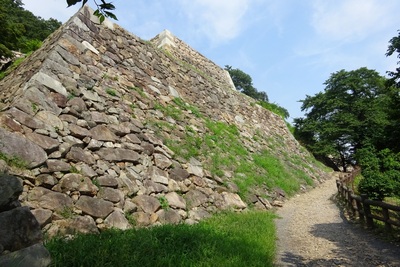
Tottori Castle's Ruins
Tottori Castle, originally built in 1532, was demolished by the government in 1881 and never rebuilt. What remains today are the stone walls of the castle and a single wooden entrance gate. The ruins are located near the city center, in a park that can be visited for free. The park is located on the slopes of Mount Kyusho, which once served as a natural defense of the castle, and climbing up the slopes, up to the highest part of the ancient castle, you can admire the view of Tottori from above. The park is very popular in April, when the hundreds of cherry trees in bloom. Finally, in the lower part of the park there is a particular white wooden building with western architecture. This is the Jinpukaku , built in 1907 by the ancient lords of the castle that was destroyed twenty-five years earlier and heirs of a feudal Japan that no longer existed. The building was the first in Tottori to have electricity and was a symbol of modernization. Today it can be visited internally and houses a small museum on the Ikeda Clan (9-17, 150¥).
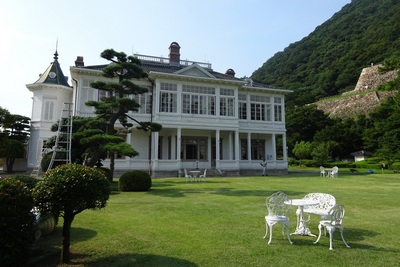
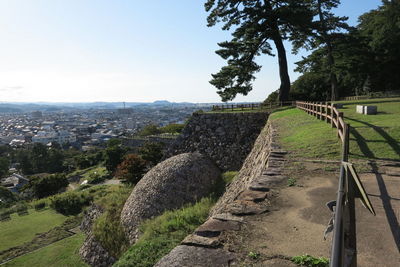
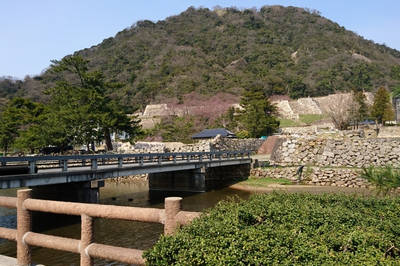
Mount Kyusho
Starting from the castle ruins, the climb of Mount Kyusho behind it takes about half an hour and offers great views of the city and surrounding area, up to the sand dunes.
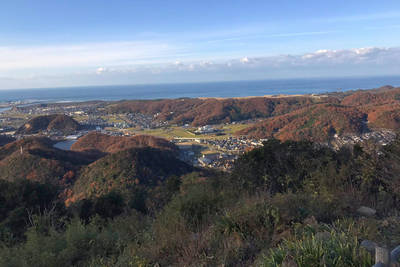
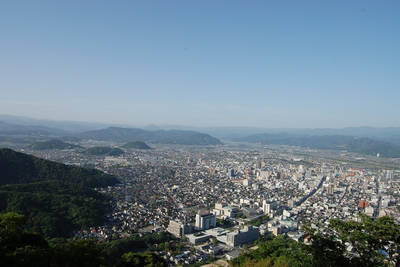 view from the top of Mount Kyusho
view from the top of Mount Kyusho
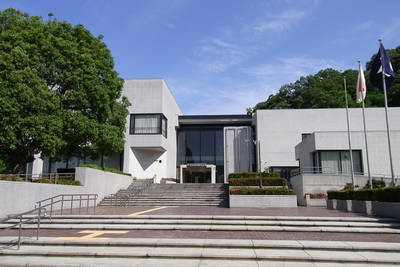
Tottori Prefectural Museum
(admission 180¥, opening hours 9-17, closed on monday)
Located near the ruins of the former city castle, this museum offers visitors an insight into the prefecture's history, art, nature and folklore. There is a section dedicated to native flora and fauna, an area on history and folklore, and an art section that exhibits pieces of ancient and modern art related in some way to the area. In addition, it hosts several special exhibitions each year, whose admission is usually paid separately.
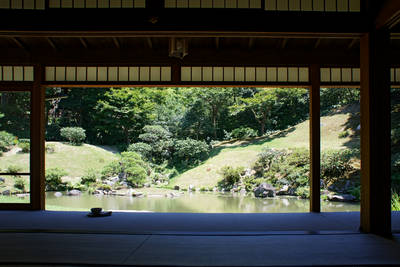
Kannon-in Temple
(admission 550¥, opening hours 9-17)
The Kannon-in is a temple of the Tendai sect of Japanese Buddhism, built during the first half of the 1600s by the ruling Ikeda family. Today it is located 1.5km south of the castle ruins and east of the station. The temple is best known for its Japanese-style landscaped garden, with a large pond surrounded by lawns and tall maple and pine trees. The entrance fee to the temple also includes a cup of matcha tea and a traditional sweet made from rice flour, sitting in front of the temple garden. You can experience this type in many places in Japan, the temple is anything but a must see for a western tourist, but it can be interesting if you want the experience of a tea in front of the garden in a less touristy atmosphere than what you feel in the most famous cities for this kind of thing like Kyoto or Kamakura.
Where to stay in Tottori
 A modern and clean hostel a stone's throw from Tottori station. As is often the case in Japan, the beds in the common rooms are arranged in a capsule hotel style, ensuring greater privacy. The lowest price in town for those on a budget.
Price range: bunk beds 2,900-3,200¥.
A modern and clean hostel a stone's throw from Tottori station. As is often the case in Japan, the beds in the common rooms are arranged in a capsule hotel style, ensuring greater privacy. The lowest price in town for those on a budget.
Price range: bunk beds 2,900-3,200¥.
 Another hostel with capsule hotel-style beds near Tottori station. Unlike the former, this one is a little more expensive, but is recommended for those looking for socializing opportunities. On the ground floor you will find a bar where you can have breakfast in the morning and where to have a drink in the evening. On the roof there is also a beer garden where various events are organized in the summer months. A shared kitchen is also available for guests.
Price range: bunk beds 3,300-4,100¥.
Another hostel with capsule hotel-style beds near Tottori station. Unlike the former, this one is a little more expensive, but is recommended for those looking for socializing opportunities. On the ground floor you will find a bar where you can have breakfast in the morning and where to have a drink in the evening. On the roof there is also a beer garden where various events are organized in the summer months. A shared kitchen is also available for guests.
Price range: bunk beds 3,300-4,100¥.
 The business hotel that we most recommend in Tottori, with low prices and super services. Although not super close to the station, the location is very good. The hotel is in fact located along the road between the station (10 minutes on foot) and the ruins of the town's castle (15 minutes walking in the opposite direction). Very useful is the free bike rental service with which you can explore the quiet city center. The breakfast buffet is phenomenal, at a ridiculously low price (880¥).
Price range: single rooms 4,000-6,000¥, double rooms 5,000-7,000¥.
The business hotel that we most recommend in Tottori, with low prices and super services. Although not super close to the station, the location is very good. The hotel is in fact located along the road between the station (10 minutes on foot) and the ruins of the town's castle (15 minutes walking in the opposite direction). Very useful is the free bike rental service with which you can explore the quiet city center. The breakfast buffet is phenomenal, at a ridiculously low price (880¥).
Price range: single rooms 4,000-6,000¥, double rooms 5,000-7,000¥.
 If, on the other hand, you need a business hotel as close as possible to the train station, the Super Hotel (a popular Japanese chain with excellent value for money) is the best of the hotels opposite the station. Among the services offered, we highlight the possibility to choose between different types of pillows for a comfortable sleep, bicycle rental, and above all the free buffet breakfast and a small public onsen with thermal water.
Price range: single rooms 7,000-8,000¥, double rooms 8,000-10,000¥.
If, on the other hand, you need a business hotel as close as possible to the train station, the Super Hotel (a popular Japanese chain with excellent value for money) is the best of the hotels opposite the station. Among the services offered, we highlight the possibility to choose between different types of pillows for a comfortable sleep, bicycle rental, and above all the free buffet breakfast and a small public onsen with thermal water.
Price range: single rooms 7,000-8,000¥, double rooms 8,000-10,000¥.
Eating in Tottori, cafes and restaurants

Pears from Tottori
Tottori prefecture is well known among the Japanese, as well as for its sand dunes, for its Asian pears (called
nashi in Japanese). The fruit is known for its pale yellow, almost translucent skin, and a delicate sweetness and juiciness. Numerous types of cookies, cakes and other sweets are now made with these pears, and there is plenty of choice in the town's souvenir shops.
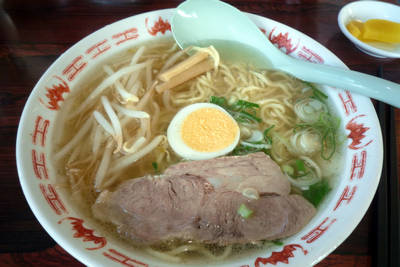
Gyuukotsu Ramen
Gyuukotsu Ramen is a local ramen originating from the central-western part of Tottori prefecture, which uses beef bones to make broth. It is very rare to find in Japan a ramen with a broth of this type, with a lighter aftertaste than the typical ramen.
How to get to Tottori
The city of Tottori is located in a position that is not easy to reach from the main cities of Japan. Given the high fares, it is advisable to consider the train only if you are in the Kansai region (Osaka, Kyoto, Kobe, Himeji) and if you have a Japan Rail Pass. Otherwise, the bus is highly recommended, both from Osaka/Kyoto and Tokyo. Finally, from Tokyo, if you don't have budget problems, you can opt for the fast, comfortable but also expensive plane.
By train
The limited-express train
JR Super Hakuto connects Kyoto and Tottori stations in 3 hours (8120¥), with a departure approximately every 2 hours. You can also take this train from some important intermediate stops, including Osaka and Shin-Osaka stations, Sannomiya (
Kobe) and Himeji (this last oneis about halfway, 1 hour and a half from Tottori, 4550 ¥). The route partially uses tracks of another railway company, and therefore is not fully covered by the Japan Rail Pass and a supplement must be added according to the city of departure. If you are coming from Tokyo or other locations in Japan, you will first need to reach the city of
Himeji, the last station of the JR Super Hakuto also served by high-speed shinkansen trains.
By plane
Tottori Airport, nicknamed
Tottori Sand Dunes Conan Airport since a few years ago, is located less than 10 km from the city center, to which it is connected by bus (20 minutes, 470¥). The airport is served by 3-4 flights per day by ANA to
Tokyo Haneda (flight duration 1 hour and 20 minutes).
By bus
If you don't have a Japan Rail Pass, and you want to save time and above all money, buses are the best way to reach Tottori. The
Nihon Kotsu Bus company offers bus connections between Tottori and Osaka/Kyoto in 3/3 and a half hours (3800¥/4070¥). The same company offers overnight bus connections from Tokyo in about 10 hours (10,700¥).
How to get to the sand dunes area
From Tottori station, just take one of the city buses to Tottori Sakyu (鳥取砂丘), and get off at the last stop. The journey takes 20 minutes and costs 380¥, with departures approximately every hour. On weekends and in August, there is also the
Kirin Jishi Loop Bus, with an additional 1-2 departures every hour (300¥ one way or 600¥ for a day pass). Finding the bus stop is very simple: just take the exit called “Sakyu Kita-guchi” from the station and go to the bus stop n.0 (yes, you got it right, zero).
Map of Tottori, Tottori
Guided tours, activities and other things to do
If you are planning a trip to Japan and you want to do something more than just visiting famous places and monuments, we suggest you to use
Rakuten Travel Experiences.
How to use Rakuten Travel Experiences
Rakuten Travel is a very useful website to
enrich your travel experience, especially if you are going solo or it's your first time in Japan.
Because of the language barrier (and more), in Japan it is very difficult to interact with the locals and to get off the tourist track.
Thanks to Rakuten Travel you can find a lot of interesting and sometimes unique
guided tours and activities all over Japan (and not only in Japan), that you would otherwise never be able to enjoy.
But there's more: on Rakuten Travel you can also
buy tickets for several famous attractions, events, transportation and other useful services for tourists. Last but not least, you can
reserve a table in hundreds of restaurants.
Some examples
Take a look at Rakuten Travel Experiences
You may also be interested in






 A modern and clean hostel a stone's throw from Tottori station. As is often the case in Japan, the beds in the common rooms are arranged in a capsule hotel style, ensuring greater privacy. The lowest price in town for those on a budget.
Price range: bunk beds 2,900-3,200¥.
A modern and clean hostel a stone's throw from Tottori station. As is often the case in Japan, the beds in the common rooms are arranged in a capsule hotel style, ensuring greater privacy. The lowest price in town for those on a budget.
Price range: bunk beds 2,900-3,200¥.
 Another hostel with capsule hotel-style beds near Tottori station. Unlike the former, this one is a little more expensive, but is recommended for those looking for socializing opportunities. On the ground floor you will find a bar where you can have breakfast in the morning and where to have a drink in the evening. On the roof there is also a beer garden where various events are organized in the summer months. A shared kitchen is also available for guests.
Price range: bunk beds 3,300-4,100¥.
Another hostel with capsule hotel-style beds near Tottori station. Unlike the former, this one is a little more expensive, but is recommended for those looking for socializing opportunities. On the ground floor you will find a bar where you can have breakfast in the morning and where to have a drink in the evening. On the roof there is also a beer garden where various events are organized in the summer months. A shared kitchen is also available for guests.
Price range: bunk beds 3,300-4,100¥.
 The business hotel that we most recommend in Tottori, with low prices and super services. Although not super close to the station, the location is very good. The hotel is in fact located along the road between the station (10 minutes on foot) and the ruins of the town's castle (15 minutes walking in the opposite direction). Very useful is the free bike rental service with which you can explore the quiet city center. The breakfast buffet is phenomenal, at a ridiculously low price (880¥).
Price range: single rooms 4,000-6,000¥, double rooms 5,000-7,000¥.
The business hotel that we most recommend in Tottori, with low prices and super services. Although not super close to the station, the location is very good. The hotel is in fact located along the road between the station (10 minutes on foot) and the ruins of the town's castle (15 minutes walking in the opposite direction). Very useful is the free bike rental service with which you can explore the quiet city center. The breakfast buffet is phenomenal, at a ridiculously low price (880¥).
Price range: single rooms 4,000-6,000¥, double rooms 5,000-7,000¥.
 If, on the other hand, you need a business hotel as close as possible to the train station, the Super Hotel (a popular Japanese chain with excellent value for money) is the best of the hotels opposite the station. Among the services offered, we highlight the possibility to choose between different types of pillows for a comfortable sleep, bicycle rental, and above all the free buffet breakfast and a small public onsen with thermal water.
Price range: single rooms 7,000-8,000¥, double rooms 8,000-10,000¥.
If, on the other hand, you need a business hotel as close as possible to the train station, the Super Hotel (a popular Japanese chain with excellent value for money) is the best of the hotels opposite the station. Among the services offered, we highlight the possibility to choose between different types of pillows for a comfortable sleep, bicycle rental, and above all the free buffet breakfast and a small public onsen with thermal water.
Price range: single rooms 7,000-8,000¥, double rooms 8,000-10,000¥.

